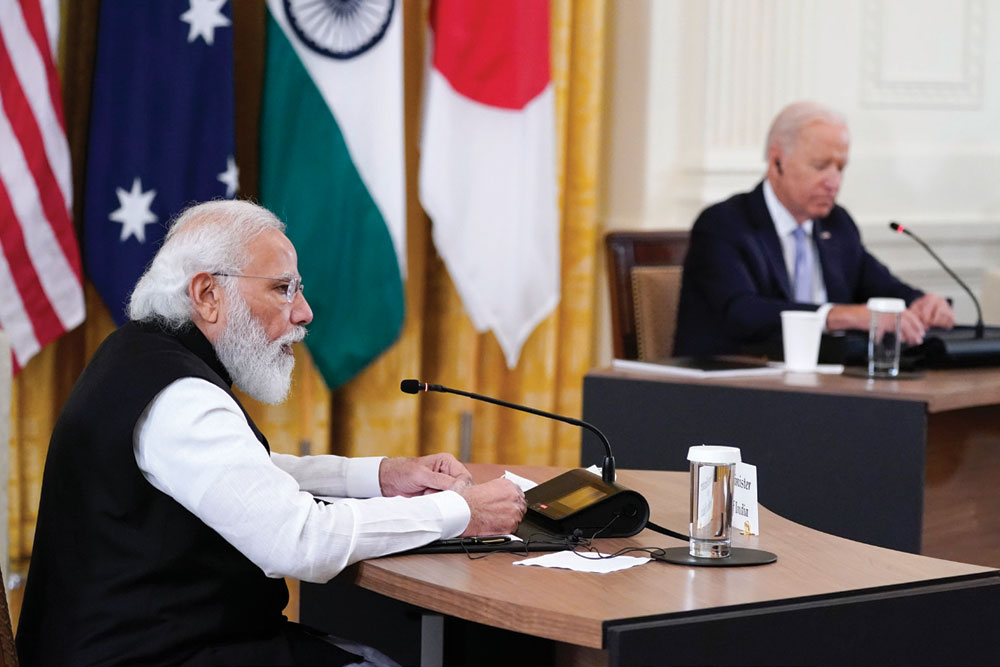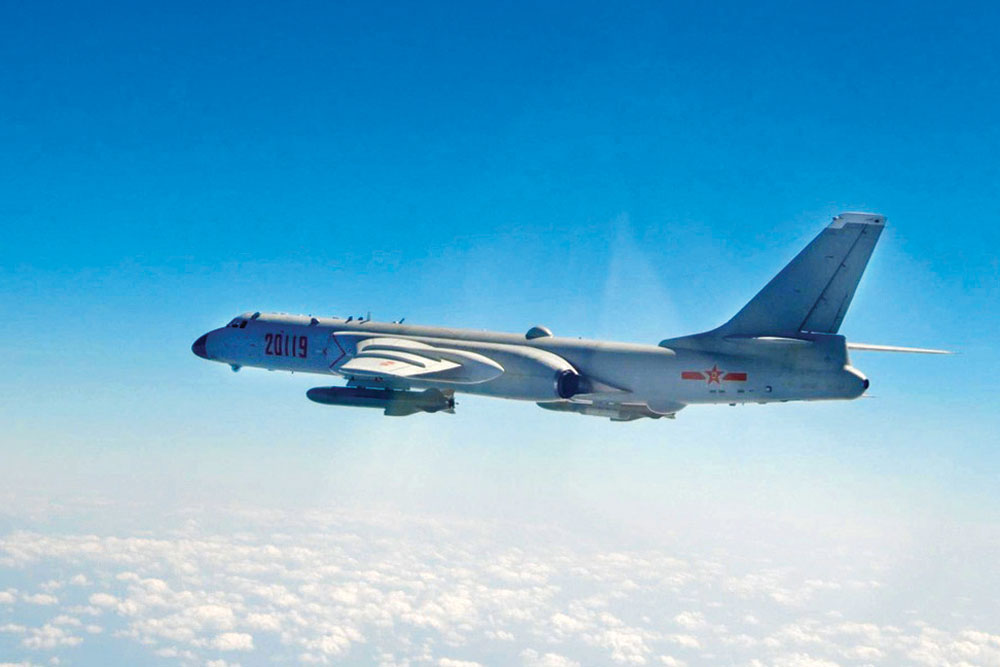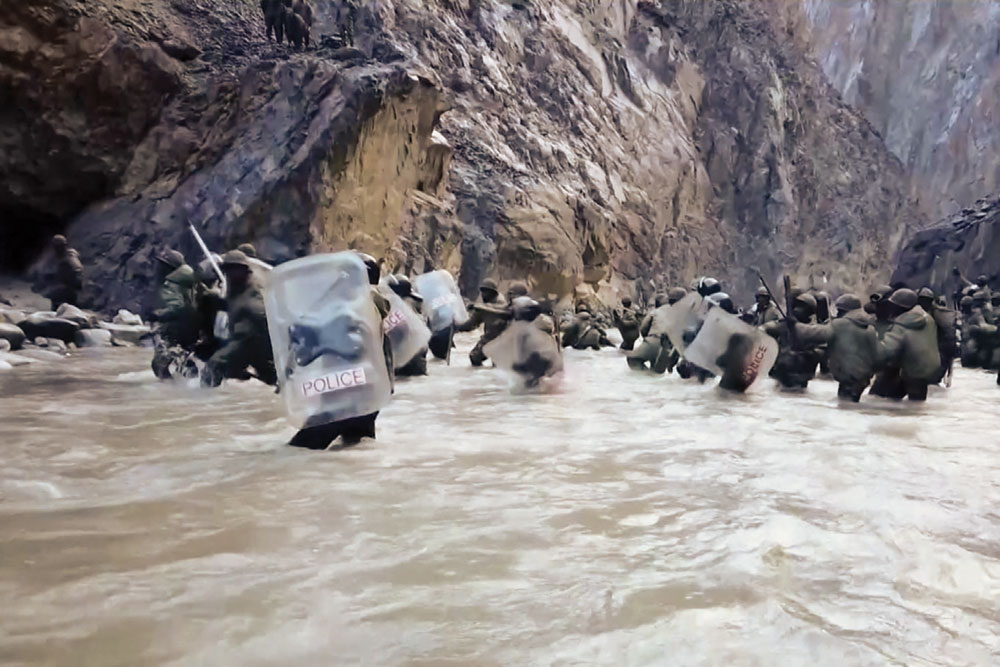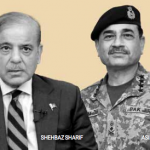A High Wind In the Himalayas
India’s strategic planning must take into account not only the changes thrown into relief by the pandemic but also the interconnectedness of global crises
 Sudeep Paul
Sudeep Paul
 Sudeep Paul
Sudeep Paul
 |
07 Jan, 2022
|
07 Jan, 2022
/wp-content/uploads/2022/01/Highwind1.jpg)
(Illustration: Saurabh Singh)
In a dark time, the eye begins to see
—Theodore Roethke
VERY FEW STRATEGIC analysts in the West, gazing into the crystal ball, seem to have seen the McMahon Line when making their forecasts for 2022. Thus, in acknowledging two obvious potential flashpoints in Taiwan and Ukraine, there’s been little to no factoring in of the likelihood and likely fallout of a broader and sharper clash on the Sino-Indian border. Predictably, while a reigniting of India-Pakistan hostilities in a hot war is mentioned in passing, the focus remains on the US-China decoupling, the Biden administration’s persistence with the Trump administration’s pressure on an ever more aggressive Beijing, and America’s room for manoeuvre in the event of a Chinese assault on or blockade of Taiwan and a Russian invasion of Ukraine. When India does come into the picture vis-à-vis China, it’s as part of the map of the Indo-Pacific. Even as there’s no disputing the significance of the maritime domain in Chinese designs and in how Beijing sees things lying off its coast, what’s probably being overlooked is the strong possibility that the Xi Jinping regime is well aware of its constraints in the South and East China Seas where the US Navy still operates in relative freedom. With a single adversary across it, there’s a perverse but easily graspable logic to the McMahon Line emerging as the focal point of the PLA’s adventurism that can put the US in a quandary worse than the Taiwan Strait or Ukraine.
Which is not to say Taiwan is not the danger it is; but the People’s Republic (PRC) may not make a full-fledged attempt to take it yet simply because Xi would want to time an annexation of Taiwan perfectly, somewhere closer to the crossing of his original term limit of 2023 that was removed in 2018, since it’s expected that the internal pressures on him would intensify around that decadal landmark. A potential Sino-Indian conflagration, while it must be placed in the overall pattern of China’s strategic gameplan—if it can be called that—and the US-China rivalry, would also end up altering global geopolitics, not least the Washington-Beijing dynamic. In the case of Taiwan, the US would have to make a difficult choice but it’s hard to see how it would avoid military involvement since its diplomatic distancing of Taipei and appeasement of Beijing on that score would have come to nought and Washington would be expected to honour a commitment. Ukraine, on the other hand, cannot lead to World War III even if Russian troops invade because the US will not militarily defend the former Soviet Republic, continuing instead with hardware and diplomatic aid to Kiev. Therefore, the most unpredictable global fallout would be of a larger Sino-Indian conflict, especially if it opened two fronts of war for New Delhi.
Just as Western analysts downplay the post-Galwan impasse at the world’s peril, India can avoid recognition of all the patterns of a post-pandemic geopolitics and their interplay, or feedback loops, at its own. The world today, and Asia in particular, mirrors not so much Europe on the eve of World War II but the Europe that was sleepwalking to World War I. That’s true also of the Sino-American great-power rivalry—it’s less Cold War, no matter how eagerly we bandy the analogy about, than the “more worrisome historical metaphor” of World War I, as Harvard academic Joseph S Nye Jr has recently argued. Something that seems inevitable need not necessarily happen and yet ends up happening because no one takes it seriously enough or everybody misreads everybody else or underestimates the danger and/or the scale. The chaotic withdrawal from Afghanistan has added to the uncertainty about the US’ global role and leadership. Talk of America looking homeward at the expense of the world may be exaggerated but it has thrown into relief the contours of a changing world order. The post-war world order since 1945, once transformed by the fall of the Soviet Union, is being laid to rest and the so-called middle powers, much as they would like things to be orderly, have a challenge and an opportunity in determining the emergence of a multi-polar world where China may be powerful but doesn’t dictate terms to one and all.

Two such middle powers, India and Russia, would find it in their mutual interest that such a multi-polar world emerged. But Moscow and Delhi, beholden to opposite ends of the US-China rivalry, are not wholly free to act on their bilateral relationship, let alone their mutual interests. Russia and India will not see a convergence of views on the Indo-Pacific and nostalgia tends to be a waste of time and energy. However, Moscow has pledged its ‘neutrality’ in the event of a Sino-Indian conflict and Putin’s recent visit has had the added advantage of both sides taking stock of Afghanistan. While India has its fingers crossed over the S-400 Triumf pertaining to sanctions under the Countering America’s Adversaries Through Sanctions Act (CAATSA) and is putting up a brave front, perhaps justifiably expecting a waiver, the ideal outcome for Delhi would be rapid indigenisation to scale back on its overwhelming dependence on foreign defence vendors. Unfortunately, what can be expected in a single year on that front when the failure to build a military-industrial complex has been the bane of Indian defence since at least the 1962 Sino-Indian war? On the other hand, cooperation with Moscow would be vital to managing the consequences of Taliban’s Afghanistan.
Two areas Delhi should pay attention to as doable imperatives are cyber security and the Quad. Cyber attacks will not see a downward trend when deterrence and enforcement don’t work. And if the Indian Navy is to consider choking China by blockading the Malacca Strait, then Delhi has to push for making the Quad more than a forum for dialogue
Notwithstanding the cliché that Covid has changed everything, the pandemic’s bearing on terrorism has not been adequately appreciated. When we throw in the fact that the Taliban, after all, are supposed to run a state and their fundamentalism is matched or eclipsed on the ground by other extremist actors like its allies Al Qaeda and the Tehrik-e-Taliban Pakistan (TTP) and rivals like Islamic State-Khorasan Province (ISK), the extent to which global security can be jeopardised from Afghanistan becomes clearer. Even as the Afghan economy disappears, the Taliban’s takeover will continue to serve as a model to Islamists from Yemen and Syria to the Sahel. The Central Asian neighbourhood looks askance at the presence of the Islamic Movement in Uzbekistan (IMU) and the East Turkistan Islamic Movement (ETIM) in Afghanistan. The pandemic precluded Islamist terror attacks in, say, Europe by closing borders and reducing the availability of civilian soft targets because of the lockdowns. However, what is only now being commented upon is the fillip Covid gave to online radicalisation. With people locked in, and more time spent on social media and the internet in general, jihadist propaganda as well as extremist political indoctrination, on both the right and the left, made capital of social disruption, expanding ideological divisions and institutional failure. The problem, of course, is compounded in poorer, institutionally weaker states, some of which have been pushed closer to the status of ‘failed state’. Globally, the fact that the pandemic reduced the scope for launching terror attacks was actually balanced out by the operational disruption of coordinated counterterrorism efforts.
Whether terrorists revert to their tried and tested modus operandi in 2022 depends on how the long tail of the pandemic plays out. As far as Afghanistan is concerned, the export of terror will concern more of its neighbourhood, from Central Asia and the Caucasus—Russia’s own near-abroad—to India, but for the rest of the world, a repeat of 9/11 from Afghan soil is unlikely, the country serving more as a role model as observed earlier rather than a resource. But terrorist non-state actors will see an increase in their value to states, such as Pakistan, that count on them as strategic force multipliers. Pakistan, notwithstanding its macroeconomic crisis, will do what it has always done and India cannot be complacent about the debt trap its neighbour to the west is walking into. (Incidentally, another neighbour, Sri Lanka, is on the verge of bankruptcy.) That doesn’t mean diplomatic pragmatism should be thrown to the wind. On the contrary, 2022 should begin by running a check on the accepted logic of a two-front war. In preparing for the worst while hoping for something less severe, India should certainly ready itself for a two-front war even if war is not imminent, but it should also invest equal attention and effort in preventing it. And therein, it might be easier to work on Islamabad than Beijing. It will be extremely difficult for Pakistan to stay out of a full-blown Sino-Indian conflict owing to both its subservience to China as well as its pursuit of retribution for India for 1971. But a right mix of diplomacy and tactical pressure—the proverbial carrot-and-stick—could persuade Islamabad-Rawalpindi to see the rewards of pragmatism and a cool head for once. Pakistan is the lesser, even if the ur, problem for post-1947 India. Delhi has nothing to lose but quite a bit to gain if Pakistan could be removed as a factor in a future conflict with China. Strategy is made in the cold light of reason, not the suffocating heat of rhetoric.

BILL EMMOTT, former editor-in-chief of The Economist, writing recently about the Global Commission for Post-Pandemic Policy’s (of which he is co-director, with Daniel Kahneman, Simon Schama, Montek Singh Ahluwalia, Siddhartha Mukherjee, Timothy Snyder, Michael Spence and Jacques Attali among its 34 commissioners) new report, ‘Our Global Condition’, argued: “[W]e are in the grip of not one but four crises. The only way forward is to recognize the connections between planetary public health, climate change, declining public trust and democratic legitimacy, and geopolitical instability. These issues are interlinked. Treating them as separate domains will get us nowhere.” That’s stating the obvious, but just because it’s obvious doesn’t make it hackneyed. Geopolitics could never be viewed in isolation from anything happening on and to the planet. If anything, the pandemic has lifted the veil on the interconnectedness of events and the feedback loops that determine how one affects the substance and course of another. The global public health crisis directly impacts institutional fragility and state vulnerability. Climate change is a potent accelerator. Public trust deficit has brought uncertainty to governance, if not the health of the state, right into the developed world. All of these bleed into geopolitical instability which in turn aggravates these crises.
China may not make a full-fledged attempt to take Taiwan yet simply because Xi would want to time an annexation perfectly. With a single adversary across it, there’s a perverse but easily graspable logic to the McMahon Line emerging as the focal point of the PLA’s adventurism that can put the US in a quandary worse than the Taiwan Strait or Ukraine
Geopolitical instability will deepen not merely because of China’s conviction that its moment has come, that it no longer needs to hide its strength and bide its time. For all we know, in abandoning caution and stealth, Beijing has already overreached, or is on the verge of doing so. At a time when its economy no longer paints the rosy picture it once did and political fissures are breaking through the PRC’s opacity, the world must also prepare for a probable more chaotic and misdirected grasp at global hegemony by Beijing. Regardless of what happens and how, there will be changes to the longstanding rules-based global order, with the West losing its prerogative in setting the rules. Underpinning this fundamental change is the 21st century’s first great-power rivalry, and although 2022 may resemble the years leading up to conflagration in 1914 with rival armed camps in Europe and the Balkan powder keg in a corner, the Kennanian focus on the big problem should never be lost because the world may yet split into two neater blocs almost evenly balanced, with little wiggle room for those who wouldn’t like to belong on either side.
The lack of a publicly available strategic document that acts as a pointer and an overview, as well as perhaps a smokescreen, doesn’t mean India lacks a strategic worldview, but the absence of such a document leaves it to second-guessing government thinking and policy. In any case, strategic planning is expected to begin on the premise that the world we inhabit is unstable, unsatisfactorily predictable and morphing and, with the pandemic acting as a powerful accelerator, operational risks for governments as well as businesses will only increase and intensify even if Covid wanes and becomes just another disease. Nothing that India does geopolitically will be independent of the myriad and mutually influencing crises of the world. From the threat of cyber attacks or the pursuit of clean energy to the unexpected consequences of the expected policy normalisation from central banks, the choices may be limited for a middle power like India. Omicron, although reportedly a less virulent variant but highly contagious, looks set to extend the pandemic’s long tail, in the process not helping global economic recovery. The global vaccination gap, where a lot of African countries can’t expect to vaccinate most of their populations until the middle of the decade, will add to the skew in a post-pandemic world. A likely threshold breach in the Middle East, with Iran reaching weapons-grade enrichment of uranium even as the chances of a fresh nuclear deal disappear, could lead to an Israeli strike on Iranian nuclear installations. The geopolitical earthquake that would trigger could be worse than the oil shocks of the 1970s.

Two areas Delhi should pay particular attention to as doable imperatives are cyber security and the Quad. The threat posed by ransomware attacks will not see a downward trend in a world where deterrence hasn’t worked and enforcement never took off. Cyber diplomacy cannot work since the stakeholders don’t see eye-to-eye and an increasing number of states have tended to condone, facilitate and even employ cyber criminals in pursuit of geopolitical force multipliers. In fact, cyber terror is one of the main fronts on the map of conflict shaping up. It’s not for nothing the US has brought equivalence between global terrorism and cyber attacks. While the US will remain the primary target of ransomware attacks, India can no longer claim innocence of experience when it comes to the threat posed to both its businesses and national security. All critical national infrastructure is vulnerable and their security must be prioritised, with special attention to energy (includes electricity) and IT, telecom and banking. Private businesses cannot expect much government help in both enhancing security and responding to attacks since, globally, cyber criminals operate safely behind the difficulty states face in indentifying perpetrators and an even bigger difficulty in enforcing the law, all efforts suffering under the lack of consensus on what those rules are and ought to be.
It will be extremely difficult for Pakistan to stay out of a full-blown Sino-Indian conflict. But a right mix of diplomacy and tactical pressure could persuade Islamabad-Rawalpindi to see the rewards of pragmatism for once. Delhi has nothing to lose but quite a bit to gain if Pakistan could be removed as a factor in a future conflict with China
China’s actions in eastern Ladakh and its longstanding designs on Arunachal Pradesh and the chicken’s neck in West Bengal connecting the Northeast to the Indian mainland do not reduce the significance of the Indo-Pacific theatre for India. Rather, if the Indian Navy is to even consider choking China by blockading the Malacca Strait, with a little help from its friends, then it has to proactively engage with those friends and push for making the Quad more than a forum for diplomatic dialogue and calendar-bound naval exercises. A good start would be dividing the Indo-Pacific into maritime patrol domains for surveillance and air-search operations, although such proposals have gone nowhere till date. Moreover, it’s time to ask what exactly Beijing would do that it’s not already doing if the Quad were to be formally militarised. Peace for our time is always an imperative, but so is seeing the writing on the wall. Geopolitics abhors a vacuum and we would not like what came after America.

/wp-content/uploads/2025/05/Cover-Spynetwork.jpg)












More Columns
Unveiling India’s PDEI Strategy Makarand R Paranjape
Such Comforting Illusions Harsh V Pant
A Winner All the Way Kaveree Bamzai